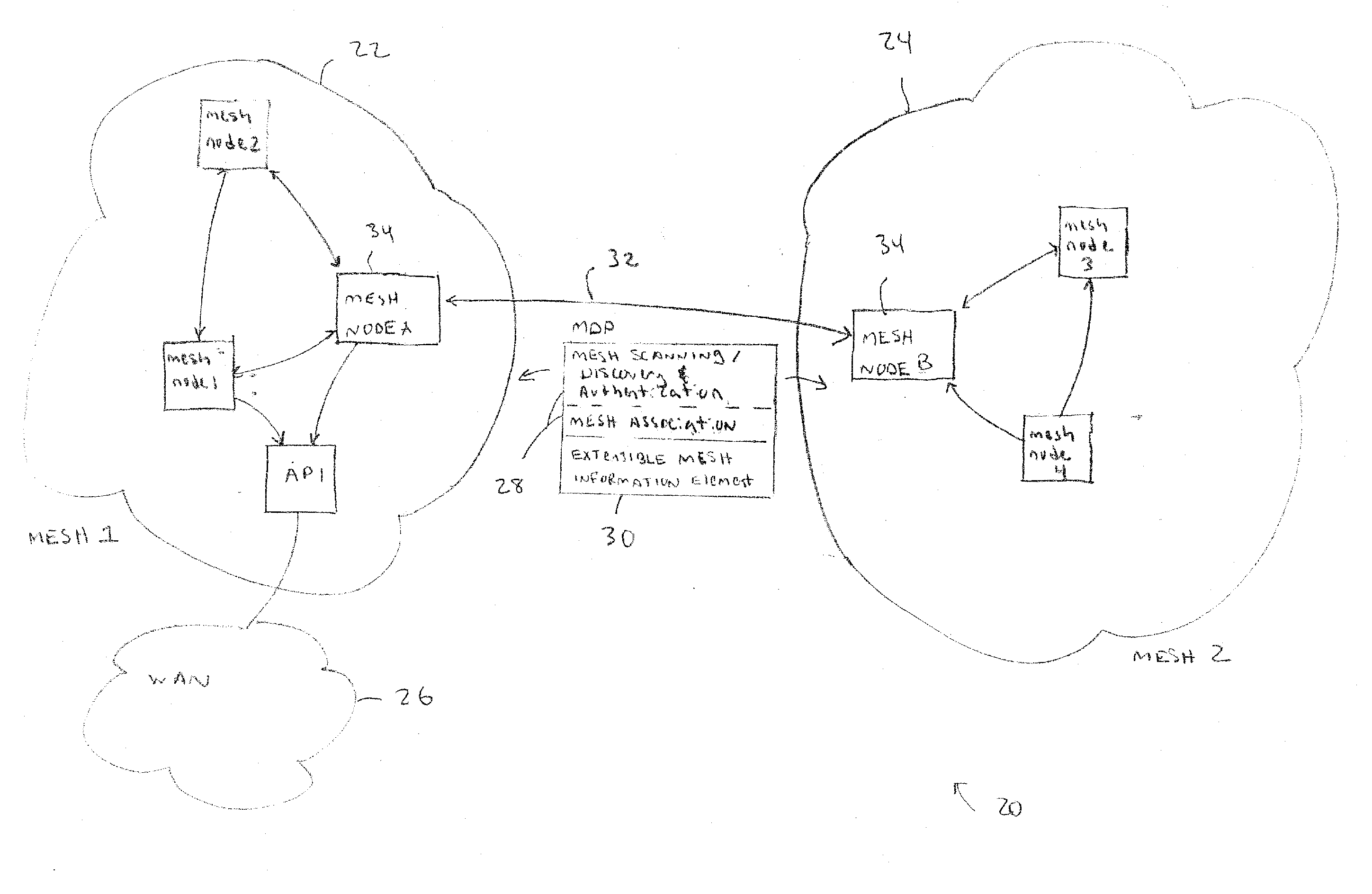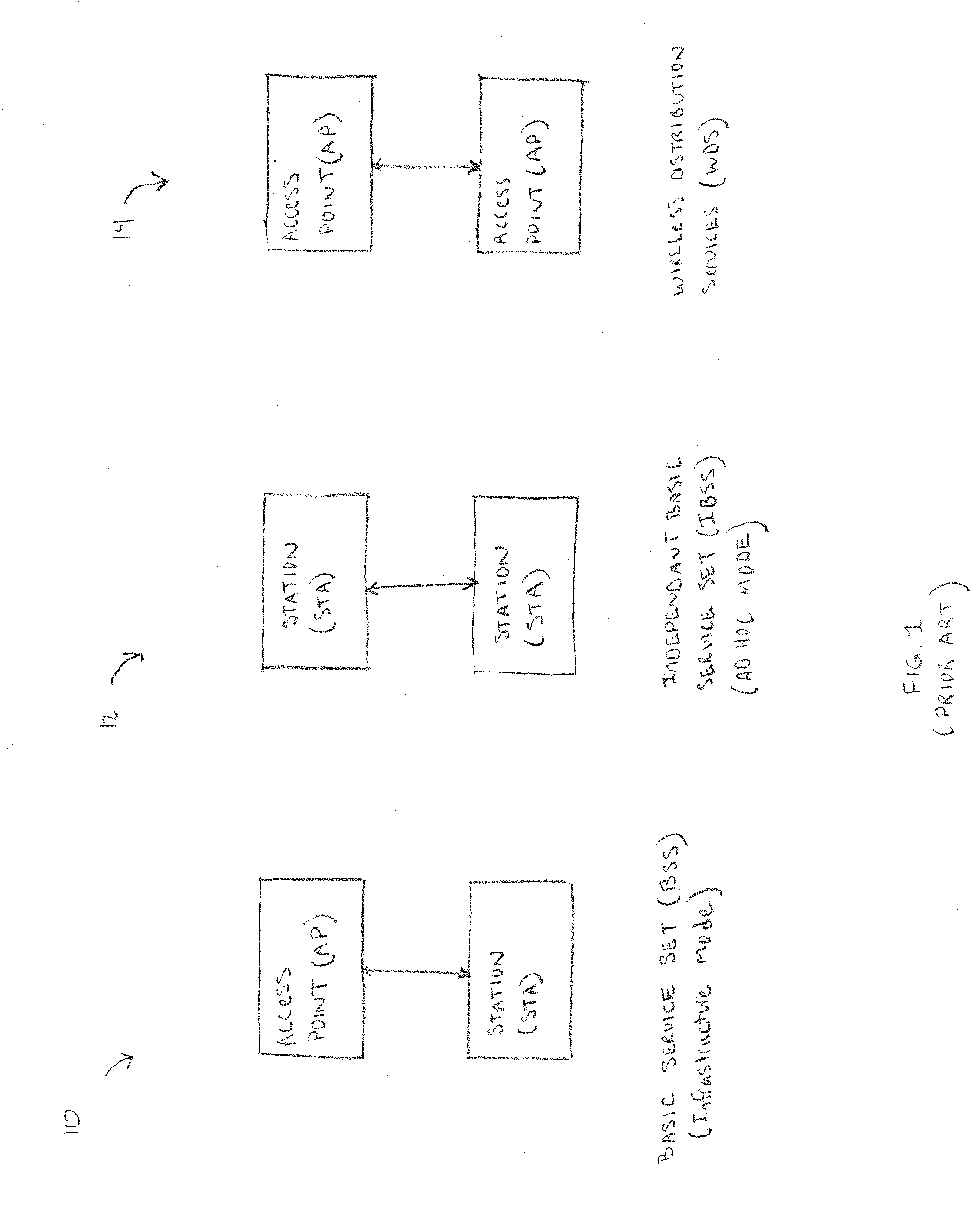Discovery and authentication scheme for wireless mesh networks
a wireless mesh network and authentication scheme technology, applied in the field of discovery and authentication scheme for wireless mesh network, can solve the problems of not providing the functionality required for effective use of ibss b>12, bss b>10/b>, and ibss b>12
- Summary
- Abstract
- Description
- Claims
- Application Information
AI Technical Summary
Benefits of technology
Problems solved by technology
Method used
Image
Examples
case 1
ed Mesh Node
[0089] When a mesh node is isolated and has no associations with either APs or other mesh nodes, the primary objectives are to find an AP on any channel, find a mesh node or nodes on any channel, or scan aggressively (passive and active) on all configured channels. Note that “configured channels” refer to all or a subset of possible wireless channels that may be defined for a particular mesh network. For example, a given mesh network might be configured only to use channels 1, 6, and 11 in the 802.11b set of channels. This would increase efficiency at the cost of reduced flexibility. Any combination of channels across any set of wireless bands may be configured for a mesh network. To achieve these objectives and referring to FIG. 4, the following technique may be used. [0090] 1. A scan is initiated every “short scan interval” which defaults to every one minute. [0091] 2. The mesh node 34 scans on all configured channels in sequence (lowest to highest). [0092] 3. Both 802...
case 2
ode with Only AP Association
[0096] When a mesh node 34 has an AP association with infrastructure, the objectives may be to maintain the AP association, find mesh nodes on the current channel, and scan passively on the current channel. To achieve these objectives, and referring again to FIG. 4, the following technique may be used. [0097] 1. A scan is initiated every “short scan interval” which defaults to every one minute. [0098] 2. The mesh node scans only on the current channel. Other channels than the current channel will not be scanned until such time as the AP association is lost. This is in order to preserve the AP association. [0099] 3. Only Mesh Probe Request frames 40 are sent since the mesh node 34 already has an AP association. Thus, 802.11 Probe Request frames 42 do not need to be sent. [0100] 4. The mesh node 34 listens for Mesh Probe Response frames 50. This is active and passive scanning, but only on the current channel. [0101] 5. If one or more Mesh Probe Response fra...
case 4
ode with Both AP and Mesh Node Associations
[0109] When a mesh node 34 has both AP and mesh node associations, the objectives may be to maintain the AP and mesh node associations, find other mesh nodes on the current channel, and scan passively on the current channel. To achieve these objectives, and referring to FIG. 4, the following operations may be performed. [0110] 1. A scan is initiated every “short scan interval” which may default to some periodic time interval. [0111] 2. The mesh node 34 scans only on the current channel. Other channels than the current channel will not be scanned until such time as the AP association is lost. This is in order to preserve the AP association. [0112] 3. Only Mesh Probe Request frames 40 are sent. This is because the mesh node already has an AP association, so 802.11 Probe Request frames 42 do not need to be sent. [0113] 4. The mesh node 34 listens for Mesh Probe Response frames 50. This is active and passive scanning, but only on the current ch...
PUM
 Login to View More
Login to View More Abstract
Description
Claims
Application Information
 Login to View More
Login to View More - R&D
- Intellectual Property
- Life Sciences
- Materials
- Tech Scout
- Unparalleled Data Quality
- Higher Quality Content
- 60% Fewer Hallucinations
Browse by: Latest US Patents, China's latest patents, Technical Efficacy Thesaurus, Application Domain, Technology Topic, Popular Technical Reports.
© 2025 PatSnap. All rights reserved.Legal|Privacy policy|Modern Slavery Act Transparency Statement|Sitemap|About US| Contact US: help@patsnap.com



